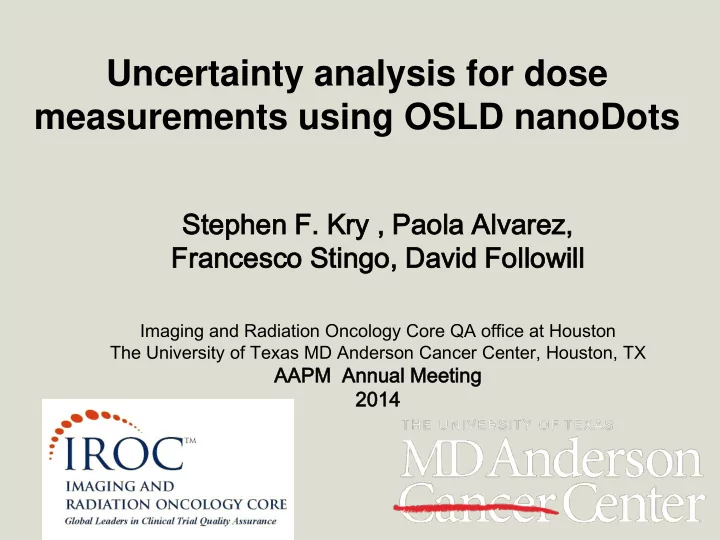

Uncertainty analysis for dose measurements using OSLD nanoDots St Stephe hen n F. F. Kr Kry , Pa Paola Al Alvare rez, z, Fr France cesco sco St Stingo, David d Fo Followill ill Imaging and Radiation Oncology Core QA office at Houston The University of Texas MD Anderson Cancer Center, Houston, TX AAPM Annual nual Meet eting ing 2014 14
Introduction • NanoDots are a popular dosimeter • IROC Houston (formerly RPC) uses OSLD to monitor beam output – Reference conditions • How precise is the OSLD program?
Dose calculation 𝑁 𝑑𝑝𝑠 = 𝑁 𝑠𝑏𝑥,𝑜 ∙ 𝑙 𝑒,𝑜 𝑜 ∙ 𝑙 𝑡,𝑗 𝑜
Methods • Estimated Uncertainty in each parameter • Based on commissioning data for batches of 5,000 – 20,000 dosimeters • Fancy error propagation – Recursive solving of: and where x is M cor and Y is the product of the remaining factors used to calculate dose. – No assumptions about shape of distribution – Accounts for cross correlation • Based on measurement with 2 detectors
Calculated Uncertainty Results 𝐸 = 𝑁 𝑑𝑝𝑠 ∙ 𝐷 𝐸 ∙ 𝑙 𝑀 ∙ 𝑙 𝐹 ∙ 𝑙 𝐺 Parameter CV (%) Reference conditions: D s 0.6 100 cGy M cor 0.8 Read after 5 days k L 0.3 Irradiated with Co-60 k E 0.8 k F 0.1 Total 1.6% For doses ranging between 90-110 cGy For time ranging between 2 and 30 days These can be expanded to 25-300 cGy and 1-120 days: The uncertainty increases to 1.7%
IROC Houston measured results • Photons: IROC-H/Inst: 0.997 +/- 1.6% • Electrons: IROC-H/Inst: 0.999 +/- 1.9%
Summary • Under well controlled conditions, 2 dosimeters provide ± 1.6% uncertainty. – 1 sigma level • This is consistent with the uncertainty in TLD measurements ( ± 1.3% for 3 detectors) Kirby et al, Med Phys 1992. • IROC Houston’s 5% criterion is reasonable
Thank You! • This work was supported by grant CA010953
Recommend
More recommend